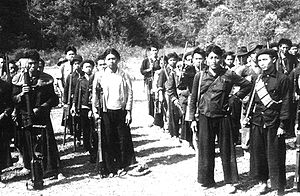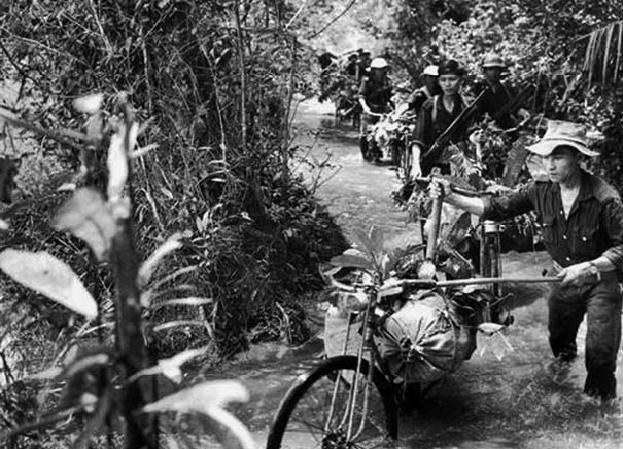(anti-communist Hmong tribe soldiers in Laos, 1961)
The majority of Americans of my generation are aware of the Vietnam War that resulted in the death of 58,315 soldiers and a 153,303 wounded, with the loss of between 1.1 to 3.2 million Vietnamese. Further, they are aware of American bombing of Cambodia and various military incursions that helped bring about Pol Pot and the “Killing Fields,” that resulted in the genocide of over 3 million Cambodians. However, that same generation was probably not aware of the civil war that raged in Laos and the American role in that conflict that witnessed 15-20 air sorties a day against that small Southeast Asian country between 1960 and 1968, that was raised to 300 sorties a day once Richard Nixon took office, resulting in the death of over 200,000 Laotians and 700 Americans.
By January 1961 Laos appeared to be on the precipice of falling to communism. Bill Lair, a ten year CIA operative flew up to the central highlands to inaugurate a bold plan labeled, Operation Momentum. The plan called for the operation and training of Hmong tribesmen, led by Vang Pao, an anti-communist officer in the Laotian army who would lead these men against the Pathet Lao who were supported by North Vietnam. The civil war in Laos had been raging on and off since the French were vanquished by North Vietnam in 1954, and Laos was declared a neutral country by the Geneva Convention of that year. Even though Laos was a small country the Eisenhower administration, firm believers in the domino theory, and that a pro-western state in Laos could serve as a buffer between Vietnam and Thailand, an American ally. Further, Laos would make it easier for the US to assist South Vietnamese forces that could help bleed Hanoi’s troops as they continued to fight the Vientiane government, and lastly it would block any communist threat to India and Southwest Asia. Joshua Kurlantzick’s new book, A GREAT PLACE TO HAVE A WAR: AMERICA IN LAOS AND THE BIRTH OF A MILITARY CIA chronicles Operation Momentum and its impact on the region and the implications for American strategy to deal with communism for decades. In addition, it raises the specter of a CIA run war through para military operators, something that continues today.
Operation Momentum was the first secret covert run war by the CIA in American history. Laos provided the CIA with the opportunity to increase the agency’s powers. According to Kurlantzick, it saw the Laotian situation as an inexpensive war in terms of money and lives to create a template for proxy wars around the world as presidents looked for ways to continue the Cold War without going to Congress for funding or involving American troops. For the CIA, after Laos, paramilitary operations would become an essential part of the agency’s mission.
(North Vietnamese troops fighting South Vietnamese troops on Laotian territory)
Kurlantzick presents a balanced and interesting narrative as he provides the background history that led to the Laotian civil war involving the Royal Laotian Army, smaller armies of different Laotian tribes, Vang Pao’s 30,000 strong Hmong army, North Vietnamese troops, and American bombing and supplying and training of anti-communist forces. As the narrative is developed the reader is introduced to a number of important characters. First of which is Bill Lair, a career CIA operative who believed the key to helping the fight for democracy in Indochina was to allow the Laotians, Cambodians, and Vietnamese to do their own fighting. The US could assist them with equipment and training, but should not be out front and appear to replace the French as a colonial power. Lair and his CIA cohorts were thrilled with the success of Vang Pao’s army in that they finally found an indigenous force that would take it to the communists. Pao was a loose cannon, but Lair knew how to control him. This relationship was successful until Washington decided to expand its operations in Laos and Vietnam under leadership of Ted Shackley who arrived as CIA Laos Station Chief in July 1966. Lair was against an increased ground war with massive bombing as he correctly believed that it would be unsuccessful in interdicting North Vietnam’s supply efforts to South Vietnam through Laos. The author’s presentation of Lair’s story is invaluable in understanding what transpires in Laos until he resigns from the CIA in August 1968. Once Lair resigns no one can control Vang Pao, and his forces who pursue a reckless strategy that has grave consequences.
(North Vietnamese troops moving supplies through Laos to South Vietnam)
Other important figures that Kurlantzick introduces are Tony Poe, a career soldier who trained and recruited Hmong tribesmen going back to 1961. After Lair resigned he developed his own 10,000 man force made up of an amalgam of tribes who he could not hold together because tribal ethnic conflict and as a result were not an effective fighting force. Perhaps the most important character in this drama was Ambassador William Sullivan, an American Foreign Service career officer who was Ambassador to Laos between 1964 and 1969. Sullivan was sent to Laos to organize the war against the Pathet Lao and became the first American ambassador to run a war from his office. Sullivan reigned in the CIA and made all operatives report to him what their plan of action was. He would approve, and even choose targets for the war, something no ambassador had ever done before. If someone did not comply, because of his relationships in Washington, they would be transferred out. Once Shackley came aboard, Sullivan supported an expansion of the war and a massive increase in bombing which was further expanded once Richard Nixon entered the White House, as Nixon had his own realpolitik for Indochina involving Communist China, and the Soviet Union in achieving the withdrawal of American troops from Vietnam.
(William Lair, CIA operative in Laos after he retired)
Kurlantzick tells a fascinating story that at times reads like fiction. There is some repetition of information, and a few factual errors, i.e.; the Viet Minh did not sign the 1954 Geneva Accords, and according to historian Fredrik Logevall, he misstates the number of American military advisors in Vietnam at the time of John F. Kennedy’s assassination, and he offers no evidence that Kennedy “repeatedly told aides he would not tolerate the loss of South Vietnam during his presidency. (Fredrik Logevall, “Laos: America’s Lesser Known Human Political Disaster in Southeast Asia,” Washington Post, February 2, 2017)
The most disturbing aspect of the war that Kurlantzick brings out has to do with the surreptitious American bombing of Laos. According to the author by 1969 the United States had dropped more bombs on Laos than it had on Japan during World War II. Further, by “1973, when the bombing campaign ended, America had launched 580,000 bombing runs in Laos. A high percentage of these bombs were antipersonnel or fragmentation bombs—which exploded into hundreds of small, deadly metal pellets on impact—antipersonnel mines, and bombs that caused widespread fires.” (177) Kurlantzick uses the massive bombing of the Plan of Jars during the summer of 1969 to highlight the devastation that resulted in the deaths and maiming of Laotian civilians. The overall bombing campaign killed civilians in disproportionate numbers and what is even more damning was the American policy of dropping excess ordinance over Laos when they could not find targets in North Vietnam and did not want to return to Thai bases with undropped bombs. In addition, Kurlantzick describes how Laos was used as a training site for bomber targeting and the indiscriminate dropping of bombs to be rid of them. America’s disdain for the Laotians can also be seen in the Paris peace talks with North Vietnam as Henry Kissinger and company sacrificed its Laotian allies in order to achieve a semblance of peace with Hanoi. By the time the Americans left Saigon, a similar withdrawal occurred in Vientiane, as by 1973 Washington had washed its hands of its former ally with devastating consequences for the tens of thousands of refugees and the poor people left behind.
(William Sullivan, American Ambassador to Laos, and later to Iran)
Despite the fact that it appears that Operation Momentum was a failure when the Pathet Lao was victorious, the CIA saw it as an unqualified success. The CIA argued that the operation occupied over 70,000 North Vietnamese troops who might otherwise have fought Americans. Further, it allowed the CIA to develop its war fighting skills to the point where paramilitary operations equaled intelligence gathering as its joint mission. The paramilitary component could be seen during the Reagan years in arming the mujahedin against the Soviet Union in Afghanistan, and arming and training of the Contras to fight against the Sandinistas in Nicaragua. After 9/11 paramilitary operations seem to have become the center of CIA activities. Today these operations are involved in Yemen, Somalia, Afghanistan, Iraq, Mali, Syria, and Pakistan. Whether through drone attacks under the aegis of the war on terror or training and supplying weapons, Operation Momentum created the CIA template for its paramilitary wars in the 21st century.
Kurlantzick offers a well-researched narrative that helps fill the vacuum of historical monographs pertaining to the war in Laos. Recently, we were reminded of the cost of that war when Barak Obama became the first American president to visit Laos and announced an increased funding to clean up unexploded ordnance that is still plaguing the Laotian countryside. Kurlantzick has written an important book that fills in a number of gaps when one thinks back to the events in Southeast Asia between 1960 and 1975 which sadly younger generations seem to be ignorant of.
(anti-communist Hmong tribe soldiers in Laos, 1961)







Wow….a scathing story. You make it hard for me to keep my reads within a different region. 🙂